#document workflow software
Explore tagged Tumblr posts
Text
Streamlining Operations with Document Automation Software for Small Business: PDQ Docs
For small businesses, managing paperwork and documentation can often become a cumbersome task, consuming valuable time and resources. From contracts and invoices to employee forms and legal documents, small business owners have to handle an array of documents daily. However, document automation software for small business, like PDQ Docs, offers an efficient and reliable solution to streamline these processes, saving time, reducing errors, and allowing business owners to focus on growth and innovation.
What is Document Automation Software?
Document automation software is designed to automate the process of creating, managing, and processing business documents. This type of software helps businesses generate professional, error-free documents quickly by using predefined templates, reducing the need for manual entry. Whether it's creating contracts, generating invoices, or filling out forms, document automation simplifies the workflow by integrating standard data and reducing human error.
Adopting document automation software for small business can lead to improved productivity and organization. Instead of spending countless hours manually drafting documents, businesses can rely on automation tools like PDQ Docs to ensure that all documents are generated quickly and accurately.

Why Small Businesses Need Document Automation Software
Small businesses often have limited resources, and inefficient document management can slow down operations, leading to missed opportunities and decreased profitability. By investing in document automation software, businesses can eliminate time-consuming manual tasks, cut down on operational costs, and maintain consistency across all their documents.
One of the key benefits of document automation software for small business is the reduction in human error. When creating documents manually, it's easy to overlook details or make mistakes, which can lead to costly errors or even legal issues. With automation, data is pulled directly from integrated sources, ensuring accuracy every time.
Moreover, automation increases the speed and efficiency of document-related tasks. Instead of creating documents from scratch, employees can use templates that automatically populate with the correct information, allowing for rapid document generation and faster decision-making. This enables small businesses to scale faster and operate more efficiently.
Why PDQ Docs is Perfect for Small Businesses
Small businesses often struggle with finding software that meets both their budgetary constraints and operational needs. PDQ Docs offers an affordable, scalable solution for businesses of all sizes, helping them streamline operations and improve efficiency without breaking the bank. The software can grow with the business, providing flexibility as needs evolve.
Conclusion
In a world where efficiency and accuracy are critical to business success, document automation software for small business is no longer a luxury—it’s a necessity. PDQ Docs offers small businesses the tools they need to automate and streamline their document management processes, saving valuable time and resources. By reducing errors, improving speed, and increasing productivity, PDQ Docs helps small businesses focus on what matters most: growth and innovation. Embracing document automation can make all the difference in staying competitive in today’s fast-paced business environment.
#document automation software for small business#document management software#automated document generation#business document workflow automation#small business document automation#paperless office solutions#document automation tools#customizable document templates#compliance document automation#document workflow software#time-saving document solutions#small business productivity tools
0 notes
Text
Enhancing Audit Workflow Management with Cutting-Edge Tools from AudTech
Introduction
In the ever-evolving landscape of finance, audit and accounting firms must adopt innovative workflow management tools to stay competitive and deliver high-quality services. This blog explores the latest trends in audit workflow management and how AudTech’s advanced software is setting new standards in the industry. https://audtech.co.in/2025/04/03/regulatory-updates-in-statutory-audits-key-compliance-changes-firms-need-to-be-aware-of/
AI and Machine Learning: The Future of Audit Efficiency
Artificial Intelligence (AI) and Machine Learning (ML) are revolutionizing audit workflows. By automating repetitive tasks, such as data collection and analysis, AI-driven tools help auditors focus on high-risk activities. AudTech’s software integrates AI to enhance data accuracy, identify anomalies, and provide predictive insights, streamlining the entire audit process.
Cloud-Based Solutions for Seamless Collaboration
Cloud computing is transforming audit workflow management by enabling real-time collaboration and accessibility. AudTech’s cloud-based platform allows auditors to access documents, share updates, and collaborate with clients from anywhere, at any time. This flexibility not only improves efficiency but also ensures that audit teams can work cohesively, even remotely.
Enhanced Data Security with Advanced Technologies
Data security is paramount in the auditing process. With increasing cyber threats, adopting robust security measures is essential. AudTech’s software incorporates state-of-the-art encryption and access control mechanisms, ensuring that sensitive financial data is protected against unauthorized access and breaches.
Real-Time Analytics and Reporting
Real-time analytics is a game-changer for auditors, providing immediate insights into financial data. AudTech’s platform offers advanced analytics tools that help auditors generate comprehensive reports quickly and accurately. This capability is crucial for making informed decisions and delivering timely audit results to clients.
Workflow Automation and Efficiency
Automated workflow management tools, such as those offered by AudTech, significantly enhance audit efficiency. These tools automate key audit processes, from planning and execution to reporting and follow-up. By reducing manual tasks, auditors can save time and focus on critical areas that require professional judgment.
Integration with Existing Systems
Modern audit workflow tools must integrate seamlessly with existing systems to maximize efficiency. AudTech’s software is designed to integrate with various financial and enterprise systems, ensuring a smooth workflow and eliminating data silos. This integration enhances data consistency and reduces the risk of errors.
Conclusion
Staying ahead in the competitive audit industry requires adopting the latest workflow management tools. AudTech’s advanced software provides auditors with the tools they need to enhance efficiency, accuracy, and client satisfaction. By leveraging AI, cloud computing, and automation, audit firms can streamline their workflows and deliver superior services in today’s digital age.
Contact
Office No. 810, 8th Floor,
LMS Finswell, Viman Nagar, Pune, Maharashtra, India, 411014
+91 9112118221 / [email protected]

0 notes
Text
Supercharge Your Business Efficiency with ShareDocs Enterpriser
Is your business still stuck in manual approvals, scattered email threads, and messy document storage? It’s time to shift gears. Meet ShareDocs Enterpriser—a powerful workflow automation solution built to streamline your document processes, save time, and improve overall efficiency.
Whether you're a small business or a large enterprise, automation is no longer optional—it’s essential. And with ShareDocs, you gain access to a complete suite of workflow automation tools and Cloud Document Management Solutions to digitize, organize, and optimize your workflows from end to end.

Why Businesses Need Workflow Automation
Manual workflows cost time, money, and often lead to costly errors. Files get misplaced, approvals are delayed, and productivity suffers.
A smart workflow automation software like ShareDocs helps you:
Eliminate repetitive tasks
Automate document movement
Improve collaboration
Maintain compliance with audit-ready trails
Enhance overall speed and accuracy
If you're still handling documents manually, you're not just behind—you're missing out on growth.
What Makes ShareDocs Enterpriser Stand Out?
✅ Smart & Customizable Workflow Automation Tools
From HR onboarding to invoice approvals, ShareDocs gives you drag-and-drop simplicity to build workflows that suit your internal processes. Automate document routing, send alerts, and monitor status in real time.
✅ Efficient Document Workflow Automation
Tired of printing, scanning, and emailing documents for approval? With ShareDocs, all your files move seamlessly through a structured process—reducing human error, speeding up decision-making, and providing full visibility.
✅ Advanced Cloud Document Management Solutions
No more digging through folders or waiting for email attachments. With ShareDocs' secure Cloud Document Management Solutions, your team can access, store, and share documents from anywhere with complete control and security.
✅ Reliable & Scalable Workflow Automation Software
Whether you're a startup or an enterprise, ShareDocs adapts to your needs. Its flexibility and security make it the best workflow automation software for industries like healthcare, finance, legal, government, and beyond.
Who Benefits Most from ShareDocs?
ShareDocs Enterpriser is trusted across sectors:
HR Departments automating offer letters, onboarding docs, and leave approvals
Finance Teams routing invoices and vendor contracts quickly
Government Offices digitizing land and legal records securely
Utilities and Enterprises maintaining audit-ready documentation workflows
Stock Exchanges ensuring secure, policy-compliant document flows
Proven Results That Drive Business Growth
Companies that implement ShareDocs report:
80% reduction in manual paperwork
50% faster approval processes
Stronger compliance and audit readiness
Improved remote collaboration
Higher employee productivity and satisfaction
This is more than software—it’s a transformation tool for modern businesses.
Why It’s the Best Workflow Automation Software
Unlike generic tools, ShareDocs Enterpriser is purpose-built to offer:
End-to-end document workflow automation
Seamless integration with existing systems
Easy user onboarding and role-based access
Bank-grade security and data protection
Local support and industry expertise
If you're looking for the best workflow automation software with long-term value and reliability, ShareDocs stands above the rest.
Get Started with ShareDocs Enterpriser Today
The shift to digital is happening fast. Don’t let outdated processes hold your business back. Automate smarter, move faster, and operate more securely with ShareDocs—the all-in-one workflow automation solution your business needs.
#workflow automation solution#document workflow automation#workflow automation tools#workflow automation software#Cloud Document Management Solutions#best workflow automation software
0 notes
Text
Benefits of Implementing ERP Software for Engineering Firms

The engineering industry is one of the biggest industries in the world, and it plays an important role in growing the economy as well. The engineering sector is growing day by day and is highly competitive. Hence, efficiency, accuracy, and streamlined operations are crucial for success in this sector. Businesses face several challenges in this sector, like the complexities of a project, resource management, and deadline restrictions. ERP software for engineering firms is the best way to overcome all of these challenges as it integrates and automates business processes.
Here is the list of top benefits of utilizing ERP systems for the engineering industry:
1. Project Management:
The projects in engineering sectors have a detailed documentation process, different teams, and complicated workflows. ERP system for engineering firms help in various ways, like centralizing project data, enabling limitless collaboration, and getting real-time updates. Because of this software, every team member has all the updates, which in turn reduces miscommunication and delays in the project.
2. Resource Management:
For all engineering projects, it is essential to allocate all resources carefully, like equipment, materials, and labor. With the utilization of ERP software, the monitoring of resources can be performed easily. It helps in checking resource availability, optimizing usage, and forecasting requirements. This ultimately results in improving cost efficiency.
3. Quality Management:
Ensures engineering projects meet industry standards and regulations.
Quality Control: Offers tools for monitoring and managing the quality of materials, processes, and completed projects.
4. Data Management:
Using ERP software, engineering firms can make sure that they can get a unified database to eliminate data silos and ensure consistency through all departments. A centralized data management system is beneficial for decision-making as well it provides critical information when required.
5. Time and Budget Management:
When the whole system gets automated with ERP software, it reduces time and cost on repetitive tasks like data entry, procurement, and inventory management. The utilization of ERP systems in engineering firms helps in reducing manual errors and improving productivity. Hence, the firms can focus on other important things like innovation and project execution.
6. Client Relationship Management:
Most ERP systems include customer relationship management tools that are very helpful in managing client interactions. This tool allows the firm to track communication history, project milestones, and client preferences. Because of this feature, firms can improve customer satisfaction and build long-term relationships.
7. Scalability and Flexibility
ERP solutions may scale with the company as it grows, allowing for more projects, clients, and resources. Customization: ERP solutions can typically be tailored to an engineering firm’s specific demands and operations.
8. Financial Management
Accounting combines financial accounting with project management to provide a complete picture of the company’s financial health. Reporting: Creates detailed financial reports, such as profit and loss statements, balance sheets, and cash flow statements.
How PMTRACK ERP Helps:
Managing development processes, monitoring complex projects, and ensuring seamless collaboration across divisions are becoming increasingly important for company success. Engineering organizations in Pune, India, and around the world have distinct issues in successfully managing their operations.
Implementing a bespoke Enterprise Resource Planning (ERP) solution provides transformative benefits by streamlining processes, improving project management, and ultimately generating profitability.
For businesses considering ERP adoption, selecting the correct ERP software vendor is critical. PMTRACK ERP, a reputable ERP solution provider in Pune, India, specializes in engineering ERP systems tailored to the demands of engineering and manufacturing companies.
ERP software is used to connect project management with financial accounting, inventory control, and procurement procedures. This integration gives project managers real-time information about project costs, resource availability, and schedules, resulting in better-informed decisions and more effective project execution.
Engineering firms that use an ERP system can improve operational efficiency, reduce costs, improve project delivery, and ultimately boost client satisfaction and profitability.
Summary:
ERP software provides several advantages to engineering firms in Pune, India, ranging from better project management and financial control to higher client satisfaction and scalability. Engineering organizations can employ a comprehensive ERP solution to improve operations, decrease inefficiencies, and drive long-term growth.
PMTRACK ERP, one of the leading ERP solution providers in Pune, India, provides comprehensive, industry-specific ERP solutions that are suitable for engineering organizations’ unique requirements. Firms that collaborate with an experienced engineering ERP software company in India receive a trusted partner in negotiating the complexity of their business, setting them up for success in an increasingly competitive landscape.
#efficiency#accuracy#and streamlined operations are crucial for success in this sector. Businesses face several challenges in this sector#like the complexities of a project#resource management#Here is the list of top benefits of utilizing ERP systems for the engineering industry:#1. Project Management:#The projects in engineering sectors have a detailed documentation process#different teams#and complicated workflows. ERP system for engineering firms help in various ways#like centralizing project data#enabling limitless collaboration#and getting real-time updates. Because of this software#every team member has all the updates#which in turn reduces miscommunication and delays in the project.#2. Resource Management:#For all engineering projects#it is essential to allocate all resources carefully#like equipment#materials#and labor. With the utilization of ERP software#the monitoring of resources can be performed easily. It helps in checking resource availability#optimizing usage#and forecasting requirements. This ultimately results in improving cost efficiency.#3. Quality Management:#Ensures engineering projects meet industry standards and regulations.#processes#and completed projects.#4. Data Management:#Using ERP software
0 notes
Text
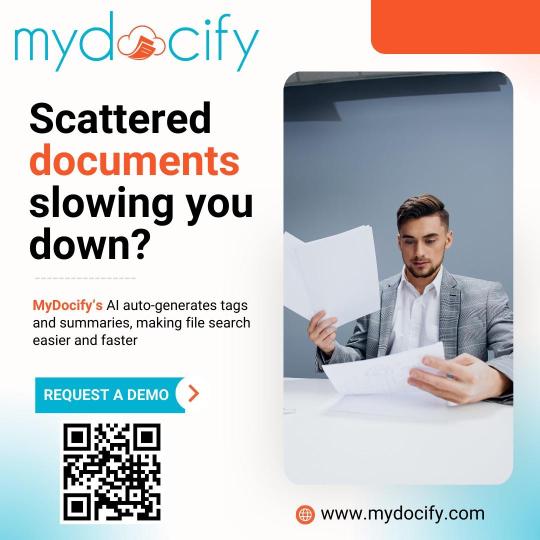
Mydocify - Streamlined Document Management Software for Businesses
Mydocify is a powerful document management software that helps businesses efficiently organize, store, and retrieve files. Experience seamless document collaboration, version control, and enhanced security with Mydocify’s cloud-based solution.
#document management software#salesforce document management#Document Workflow#Secure and Efficient File Organization#marketing#branding
0 notes
Text
Top 10 ChatGPT Prompts For Software Developers

ChatGPT can do a lot more than just code creation and this blog post is going to be all about that. We have curated a list of ChatGPT prompts that will help software developers with their everyday tasks. ChatGPT can respond to questions and can compose codes making it a very helpful tool for software engineers.
While this AI tool can help developers with the entire SDLC (Software Development Lifecycle), it is important to understand how to use the prompts effectively for different needs.
Prompt engineering gives users accurate results. Since ChatGPT accepts prompts, we receive more precise answers. But a lot depends on how these prompts are formulated.
To Get The Best Out Of ChatGPT, Your Prompts Should Be:
Clear and well-defined. The more detailed your prompts, the better suggestions you will receive from ChatGPT.
Specify the functionality and programming language. Not specifying what you exactly need might not give you the desired results.
Phrase your prompts in a natural language, as if asking someone for help. This will make ChatGPT understand your problem better and give more relevant outputs.
Avoid unnecessary information and ambiguity. Keep it not only to the point but also inclusive of all important details.
Top ChatGPT Prompts For Software Developers
Let’s quickly have a look at some of the best ChatGPT prompts to assist you with various stages of your Software development lifecycle.
1. For Practicing SQL Commands;

2. For Becoming A Programming Language Interpreter;

3. For Creating Regular Expressions Since They Help In Managing, Locating, And Matching Text.

4. For Generating Architectural Diagrams For Your Software Requirements.
Prompt Examples: I want you to act as a Graphviz DOT generator, an expert to create meaningful diagrams. The diagram should have at least n nodes (I specify n in my input by writing [n], 10 being the default value) and to be an accurate and complex representation of the given input. Each node is indexed by a number to reduce the size of the output, should not include any styling, and with layout=neato, overlap=false, node [shape=rectangle] as parameters. The code should be valid, bugless and returned on a single line, without any explanation. Provide a clear and organized diagram, the relationships between the nodes have to make sense for an expert of that input. My first diagram is: “The water cycle [8]”.

5. For Solving Git Problems And Getting Guidance On Overcoming Them.
Prompt Examples: “Explain how to resolve this Git merge conflict: [conflict details].” 6. For Code generation- ChatGPT can help generate a code based on descriptions given by you. It can write pieces of codes based on the requirements given in the input. Prompt Examples: -Write a program/function to {explain functionality} in {programming language} -Create a code snippet for checking if a file exists in Python. -Create a function that merges two lists into a dictionary in JavaScript.
7. For Code Review And Debugging: ChatGPT Can Review Your Code Snippet And Also Share Bugs.
Prompt Examples: -Here’s a C# code snippet. The function is supposed to return the maximum value from the given list, but it’s not returning the expected output. Can you identify the problem? [Enter your code here] -Can you help me debug this error message from my C# program: [error message] -Help me debug this Python script that processes a list of objects and suggests possible fixes. [Enter your code here]
8. For Knowing The Coding Best Practices And Principles: It Is Very Important To Be Updated With Industry’s Best Practices In Coding. This Helps To Maintain The Codebase When The Organization Grows.
Prompt Examples: -What are some common mistakes to avoid when writing code? -What are the best practices for security testing? -Show me best practices for writing {concept or function} in {programming language}.
9. For Code Optimization: ChatGPT Can Help Optimize The Code And Enhance Its Readability And Performance To Make It Look More Efficient.
Prompt Examples: -Optimize the following {programming language} code which {explain the functioning}: {code snippet} -Suggest improvements to optimize this C# function: [code snippet] -What are some strategies for reducing memory usage and optimizing data structures?
10. For Creating Boilerplate Code: ChatGPT Can Help In Boilerplate Code Generation.
Prompt Examples: -Create a basic Java Spring Boot application boilerplate code. -Create a basic Python class boilerplate code
11. For Bug Fixes: Using ChatGPT Helps Fixing The Bugs Thus Saving A Large Chunk Of Time In Software Development And Also Increasing Productivity.
Prompt Examples: -How do I fix the following {programming language} code which {explain the functioning}? {code snippet} -Can you generate a bug report? -Find bugs in the following JavaScript code: (enter code)
12. Code Refactoring- ChatGPt Can Refactor The Code And Reduce Errors To Enhance Code Efficiency, Thus Making It Easier To Modify In The Future.
Prompt Examples –What are some techniques for refactoring code to improve code reuse and promote the use of design patterns? -I have duplicate code in my project. How can I refactor it to eliminate redundancy?
13. For Choosing Deployment Strategies- ChatGPT Can Suggest Deployment Strategies Best Suited For A Particular Project And To Ensure That It Runs Smoothly.
Prompt Examples -What are the best deployment strategies for this software project? {explain the project} -What are the best practices for version control and release management?
14. For Creating Unit Tests- ChatGPT Can Write Test Cases For You
Prompt Examples: -How does test-driven development help improve code quality? -What are some best practices for implementing test-driven development in a project? These were some prompt examples for you that we sourced on the basis of different requirements a developer can have. So whether you have to generate a code or understand a concept, ChatGPT can really make a developer’s life by doing a lot of tasks. However, it certainly comes with its own set of challenges and cannot always be completely correct. So it is advisable to cross-check the responses. Hope this helps. Visit us- Intelliatech
#ChatGPT prompts#Developers#Terminal commands#JavaScript console#API integration#SQL commands#Programming language interpreter#Regular expressions#Code debugging#Architectural diagrams#Performance optimization#Git merge conflicts#Prompt engineering#Code generation#Code refactoring#Debugging#Coding best practices#Code optimization#Code commenting#Boilerplate code#Software developers#Programming challenges#Software documentation#Workflow automation#SDLC (Software Development Lifecycle)#Project planning#Software requirements#Design patterns#Deployment strategies#Security testing
0 notes
Text
Overcoming Pain Points with Document management Solutions
Cloud Document Management: Difficulty in managing documents stored in the cloud, leading to security and access concerns Workflow Automation: Lack of automation results in time-consuming and error-prone document workflows Document Lifecycle Management: Challenges in managing documents throughout their lifecycle, from creation to disposal Workflow Tracking: Inability to track the status of documents throughout the workflow process Access and Version Control: Difficulty in controlling access to documents and tracking document versions accurately Centralized File Management: Document management software provides a centralized repository for storing and accessing files, improving organization and accessibility.
About the Sunsmart: SunSmart tackles cloud storage complexities, automates workflows, simplifies document lifecycle management, enables real-time tracking, and ensures precise access control. With centralized file management, SunSmart enhances organization and accessibility, providing a seamless solution to document management hurdles.
Contact us : website - https://www.sunsmart.co.in/product/document-management-software-india-chennai-mumbai-bangalore-delhi.html | https://www.sunsmartglobal.com/document-management-software-dubai-qatar-uae-usa-london/ Whatsup - https://wa.link/g2d5fw mail - [email protected]
Follow us: Twitter - https://twitter.com/home Instagram - https://www.instagram.com/sunsmartglobal/ Linkedin - https://www.linkedin.com/in/sunsmart-global-1b68a6143/ Facebook - https://www.facebook.com/
0 notes
Text
DMS Blog 1 Top 5 Key Features Using Document Management Software for an HR Department
SEO Meta-Description: Explore the top 5 key features that a document management software offers for enhancing HR department efficiency, including secure access control, document version control, integration with HR systems, compliance, and more.
Introduction
Managing documents efficiently is crucial for HR departments to streamline operations and enhance productivity. Document management software plays a pivotal role in achieving these goals by offering a range of key features tailored for HR needs.
What is Document Management Software?
Document Management Software (DMS) is a digital solution designed to organize, store, and track documents and information digitally. It eliminates the need for paper-based document handling and provides a centralized platform for managing HR-related documents.
Importance in HR Departments
For HR departments, DMS is indispensable as it simplifies document handling, reduces errors, ensures compliance with regulations, and enhances data security and confidentiality.
Benefits for HR Operations
Implementing DMS in HR operations brings numerous benefits, including improved efficiency, faster document retrieval, better collaboration among team members, reduced costs associated with manual paperwork, and enhanced data accuracy.
Challenges in HR Document Management
Despite its benefits, HR document management comes with challenges such as data security concerns, compliance requirements, document version control issues, and ensuring seamless integration with existing HR systems.
Key Feature 1: Secure Access Control
User Permissions: DMS allows HR admins to assign specific access permissions to users based on their roles and responsibilities, ensuring data confidentiality and preventing unauthorized access.
Role-Based Access: With role-based access control, HR staff can access only the information relevant to their roles, maintaining data integrity and confidentiality within the organization.
Audit Trails: DMS generates audit trails that track document access, modifications, and activities, providing transparency and accountability in document management processes.
Key Feature 2: Document Version Control
Version History: DMS maintains a detailed version history of documents, allowing HR teams to track changes, revert to previous versions if needed, and ensure document accuracy and compliance.
Revision Tracking: The software tracks revisions made to documents, including who made the changes and when, facilitating collaboration while maintaining version control.
Key Feature 3: Document Search and Retrieval
Full-Text Search: DMS enables HR professionals to perform full-text searches across documents, making it easy to locate specific information quickly and efficiently.
Metadata Tagging: By tagging documents with metadata such as keywords, categories, and tags, DMS enhances searchability and categorization, improving document retrieval processes.
Key Feature 4: Integration with HR Systems
Seamless Data Exchange: DMS seamlessly integrates with existing HR systems, allowing for automated data exchange, synchronization of employee records, and streamlined workflows.
Automated Workflows: Integration with HR systems enables automated workflows for tasks such as employee onboarding, performance reviews, and compliance checks, improving HR efficiency.
Key Feature 5: Compliance and Security
Data Encryption: DMS employs robust encryption techniques to protect sensitive HR data, ensuring compliance with data protection regulations and safeguarding against data breaches.
Compliance Checks: The software conducts compliance checks to ensure HR documents adhere to regulatory requirements, helping organizations avoid legal risks and penalties.
Disaster Recovery: DMS includes disaster recovery features such as data backup, recovery options, and continuity planning, minimizing data loss and downtime during unforeseen events.
FAQs
How does Document Management Software improve HR efficiency?
Document Management Software automates document handling, enhances collaboration, ensures data security, and streamlines workflows, leading to improved HR efficiency.
What are the key security features of Document Management Software?
Document Management Software offers features like data encryption, access control, audit trails, compliance checks, and disaster recovery to ensure robust security for HR documents.
Can Document Management Software integrate with other HR systems?
Yes, Document Management Software can seamlessly integrate with existing HR systems, enabling automated data exchange, workflow synchronization, and enhanced operational efficiency.
How does Document Version Control benefit HR departments?
Document Version Control enables HR departments to track document changes, maintain version history, ensure compliance, and collaborate effectively while maintaining data accuracy.
What compliance regulations does Document Management Software adhere to?
Document Management Software adheres to various compliance regulations such as GDPR, HIPAA, SOX, and industry-specific standards, ensuring data protection and regulatory compliance.
How does Document Management Software enhance document search and retrieval?
Document Management Software offers full-text search capabilities, metadata tagging, advanced search filters, and categorization features, making document search and retrieval efficient and accurate.
Conclusion
In conclusion, Document Management Software provides HR departments with essential tools to streamline document management, enhance collaboration, ensure data security and compliance, and improve overall operational efficiency. By leveraging the top 5 key features discussed, HR professionals can optimize their workflows, mitigate risks, and focus on strategic HR initiatives.
<a href="https://www.nte.ai/Blog/business/dms-blog-1-top-5-key-features-using-document-management-software-for-an-hr-department/ ?utm_source=backlink&utm_medium=directory+submission&utm_campaign=organic">Visit nte.ai</a>
0 notes
Text
#Employee monitoring software#Time tracking tool#Productivity monitoring#Attendance tracking#Application monitoring#Website monitoring#Data security#Employee accountability#Remote employee monitoring#Keystroke logging#Screenshot capturing#File and document tracking#Workflow optimization#Data encryption
1 note
·
View note
Text




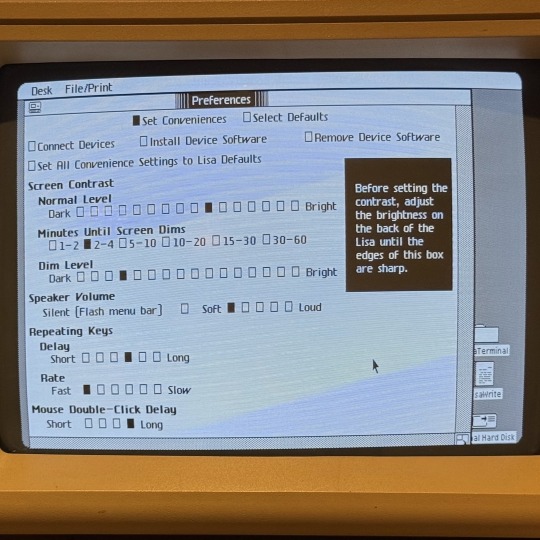





🎄💾🗓️ Day 9: Retrocomputing Advent Calendar - The Apple Lisa 🎄💾🗓️
The Apple Lisa, introduced on January 19, 1983, was a pioneering personal computer notable for its graphical user interface (GUI) and mouse input, a big departure from text-based command-line interfaces. Featured a Motorola 68000 CPU running at 5 MHz, 1 MB of RAM (expandable to 2 MB), and a 12-inch monochrome display with a resolution of 720×364 pixels. The system initially included dual 5.25-inch "Twiggy" floppy drives, later replaced by a single 3.5-inch Sony floppy drive in the Lisa 2 model. An optional 5 or 10 MB external ProFile hard drive provided more storage.
The Lisa's price of $9,995 (equivalent to approximately $30,600 in 2023) and performance issues held back its commercial success; sales were estimated at about 10,000 units.
It introduced advanced concepts such as memory protection and a document-oriented workflow, which influenced future Apple products and personal computing.
The Lisa's legacy had a huge impact on Apple computers, specifically the Macintosh line, which adopted and refined many of its features. While the Lisa was not exactly a commercial success, its contributions to the evolution of user-friendly computing interfaces are widely recognized in computing history.
These screen pictures come from Adafruit fan Philip " It still boots up from the Twiggy hard drive and runs. It also has a complete Pascal Development System." …"mine is a Lisa 2 with the 3.5” floppy and the 5 MB hard disk. In addition all of the unsold Lisa machines reached an ignominious end."
What end was that? From the Verge -
In September 1989, according to a news article, Apple buried about 2,700 unsold Lisa computers in Logan, Utah at a very closely guarded garbage dump. The Lisa was released in 1983, and it was Apple’s first stab at a truly modern, graphically driven computer: it had a mouse, windows, icons, menus, and other things we’ve all come to expect from “user-friendly” desktops. It had those features a full year before the release of the Macintosh.
Article, and video…
youtube
Check out the Apple Lisa page on Wikipedia
, the Computer History's article -
and the National Museum of American History – Behring center -
Have first computer memories? Post’em up in the comments, or post yours on socialz’ and tag them #firstcomputer #retrocomputing – See you back here tomorrow!
#applelisa#retrocomputing#firstcomputer#applehistory#computinghistory#vintagecomputers#macintosh#1980scomputers#applecomputer#gui#vintagehardware#personalcomputers#motorola68000#technostalgia#twiggydrive#floppydisk#graphicalinterface#applefans#computinginnovation#historictech#computerlegacy#techthrowback#techhistory#memoryprotection#profiledrive#userinterface#firstmac#computermilestone#techmemories#1983tech
113 notes
·
View notes
Text
Unlocking Efficiency with the Ultimate Document Management Software: PDQ Docs
Document management is considered highly important in today’s fast-paced business world. From tracking important files to collaborating with teams, managing documents can quickly become overwhelming without the right tools. That’s where the ultimate document management software, PDQ Docs, steps in. With its robust features and user-friendly interface, PDQ Docs is designed to simplify document storage, retrieval, and collaboration, making it an essential tool for any organization looking to improve productivity and organization.
Seamless Collaboration and Sharing
Collaboration is at the heart of most business operations, and PDQ Docs makes working together on documents effortless. With built-in sharing capabilities, you can grant access to team members, clients, or partners with just a few clicks. The ultimate document management software allows for real-time collaboration, so multiple users can work on the same document simultaneously, without the fear of overwriting each other’s changes. In addition, PDQ Docs offers version control, meaning all edits are tracked, and you can easily revert to previous versions if necessary. This feature ensures that everyone is on the same page, streamlining workflow and reducing the risk of errors.

Enhanced Security and Compliance
When it comes to managing sensitive information, security is a top concern for any business. PDQ Docs understands this need and offers advanced security features to protect your documents. With encrypted storage and secure access controls, you can ensure that only authorized individuals can view or edit certain files. The ultimate document management software also supports multi-factor authentication, adding an extra layer of protection. For businesses that need to comply with industry regulations, PDQ Docs is built with compliance in mind. The software adheres to best practices for data protection and privacy, helping businesses meet the requirements of standards like HIPAA, GDPR, and more.
Efficient Document Search and Retrieval
Searching for a document in a traditional file system can be time-consuming and frustrating. However, PDQ Docs simplifies this process with powerful search functionality. Its robust search engine allows users to search by keywords, tags, or metadata, making it easy to locate any document within seconds. Whether you need to find a specific contract or retrieve an old invoice, PDQ Docs ensures that every file is just a few clicks away. This feature not only saves time but also enhances productivity by minimizing the effort required to manage documents.
Conclusion
In today’s digital landscape, efficient document management is a key factor in maintaining productivity and organization. PDQ Docs stands out as the ultimate document management software, offering streamlined organization, seamless collaboration, enhanced security, and powerful search capabilities. With its scalability and user-friendly interface, PDQ Docs is the ideal solution for businesses looking to take control of their documents and improve overall efficiency. By choosing PDQ Docs, organizations can ensure that their document management processes are as effective and secure as possible, allowing them to focus on what truly matters: growing their business.
#ultimate document management software#document management system#file organization software#central based document storage#enterprise document management#document collaboration tools#version control for documents#secure file sharing software#paperless office solution#document workflow automation#business document management#document archiving system
0 notes
Text
The Shift to Cloud-Based Auditing – Why Firms Are Moving Towards Digital Audit Solutions
The auditing landscape is undergoing a massive transformation with the rapid adoption of cloud-based audit software. As regulatory requirements grow stricter and businesses seek efficiency, firms are shifting towards audit workflow management software to streamline processes, enhance security, and ensure compliance. This digital shift is not just a trend—it’s a necessity for firms aiming to stay competitive in a rapidly evolving financial environment.
The Need for Digital Audit Solutions
Traditional auditing methods relied heavily on manual data entry, paper-based documentation, and inefficient workflow management. These outdated processes often led to errors, compliance risks, and delays in report generation. The rise of audit automation software has eliminated these challenges by providing real-time collaboration, automated reporting, and AI-powered insights for auditors and accountants.
Key drivers for the adoption of cloud-based audit software include:
Increasing regulatory scrutiny and compliance complexities
The need for secure, remote access to audit files
Demand for enhanced accuracy and reduced manual errors
Efficient management of large volumes of financial data
Cost-effectiveness and scalability of cloud solutions
Benefits of Cloud-Based Audit Solutions
Enhanced Workflow Automation
A cloud-based audit workflow management system helps firms automate repetitive tasks, improving efficiency and productivity. Features like audit file management software and audit sampling software enable auditors to manage documentation, track workflows, and generate reports with minimal effort.
Improved Data Security and Compliance
Cloud-based audit management software solutions come with robust security measures, including encryption, multi-factor authentication, and compliance with international data protection standards. Unlike traditional on-premise audit tools, cloud solutions offer automated updates to meet regulatory changes in statutory audits. https://audtech.co.in/2025/04/08/the-shift-to-cloud-based-auditing-why-firms-are-moving-towards-digital-audit-solutions/
Seamless Collaboration and Remote Access
With firms adopting hybrid and remote work models, audit workflow software enables real-time collaboration. Team members can access audit files securely from anywhere, reducing dependency on physical office spaces. This feature is especially beneficial for statutory audit firms that handle global clients.
Cost-efficiency and Scalability
Cloud-based audit digitization software reduces infrastructure costs, eliminating the need for physical servers and extensive IT maintenance. Firms can scale their audit management software as needed, ensuring flexibility in handling audits of varying complexities.
Advanced Analytics and AI-Powered Insights
Modern audit software for accountants and CPA firms integrates data analytics tools to detect anomalies, assess risks, and provide predictive insights. This enhances decision-making and strengthens the overall audit process by identifying potential fraud or compliance breaches early.
Key Compliance Challenges Addressed by Cloud Auditing
One of the primary reasons firms are shifting towards cloud-based audit automation software is to ensure compliance with ever-changing regulatory requirements. The latest audit quality maturity models emphasize the importance of audit sampling tools, digital record-keeping, and automated compliance checks. Top statutory audit software solutions now include built-in regulatory updates, reducing the burden on firms to track compliance changes manually.
Implementing Cloud-Based Auditing – Best Practices
To fully leverage the benefits of audit workflow management, firms should follow these best practices:
Choose the Right Audit Management Software – Select a solution with audit file management, document collaboration, and compliance tracking.
Train Your Team – Ensure auditors and accountants are well-trained in using audit automation software to maximize efficiency.
Prioritize Data Security – Implement strict security protocols, including multi-layer encryption and access control features.
Monitor Regulatory Updates – Use software with built-in compliance tracking to stay aligned with statutory audit regulations.
Conclusion
The shift to cloud-based audit solutions is no longer optional—it’s an industry standard for firms aiming to improve efficiency, compliance, and security. Investing in audit workflow software enables firms to stay ahead in an increasingly complex regulatory environment while optimizing operations. By adopting audit automation software, firms can reduce errors, enhance collaboration, and ensure compliance with evolving audit regulations.
Whether you’re a small CPA firm or a large accounting practice, upgrading to cloud-based audit tools will future-proof your business and position it for long-term success.
Optimize your audit process today with a powerful cloud-based solution. Explore the best-in-class audit software tailored for statutory audits, financial reporting, and compliance management.
Contact
Office No. 810, 8th Floor,
LMS Finswell, Viman Nagar, Pune, Maharashtra, India, 411014
+91 9112118221 / [email protected]

0 notes
Text
HIPAA Automation: Simplify Compliance & Boost Security
HIPAA Automation uses technology to simplify compliance, reduce manual work and increase efficiency. With automated tools you can do self-audits, manage security policies, track risks and be continuously compliant with HIPAA regulations. This saves time and resources and minimizes human error that can lead to non-compliance. HIPAA compliant workflow automation lets healthcare providers simplify compliance and focus on patient care.

Why Do You Need HIPAA Automation?
Healthcare organizations handle huge amounts of patient data, manual compliance is a cumbersome and time consuming task. Automating HIPAA compliance with healthcare regulatory compliance software has many benefits:
Ensures Regulatory Compliance – Automation helps organizations follow HIPAA rules for patient data.
Enhances Risk Management – Automated tools streamline risk assessments and policy enforcement.
Reduces Data Breach Risks – Security automation minimizes vulnerabilities and protects sensitive information.
Keeps Up with Changing Regulations – Compliance requirements change and automation keeps up.
Improves Accuracy and Efficiency – Automation reduces human error and ensures consistency in enforcement.
Strengthens Healthcare Data Security – With healthcare data security solutions organizations can protect patient records from breaches and cyber threats.
Steps to Get Started with HIPAA Automation
Understand HIPAA: Before you start with automation, get familiar with HIPAA’s Security Rule, Privacy Rule and Breach Notification requirements. This knowledge is key to choosing the right healthcare regulatory compliance software.
Conduct a Compliance Risk Assessment: Identify compliance risks by evaluating your organization’s policies and procedures. A thorough risk assessment will uncover vulnerabilities and ensure your compliance program is aligned with regulatory requirements.
Choose the Right Automation Tool: Select an automation tool that integrates with your existing systems. Common tools are HIPAA compliant workflow automation, Identity and Access Management (IAM), Security Information and Event Management (SIEM) and policy management platforms. Comprehensive solutions like Sprinto can handle all aspects of HIPAA compliance automation.
Test the Automation Tool: Once you’ve selected a tool, integrate it into your system and test thoroughly to ensure it meets HIPAA standards and works.
Train Your Employees: Compliance is not just about software; employees need to be trained on HIPAA and automation tools. Proper training ensures staff members know their role in maintaining compliance.
Monitor and Continuously Evaluate: After automation, monitor its effectiveness, update policies as needed and be compliant with evolving HIPAA regulations. Regular assessments supported by healthcare data security solutions will help you identify areas for improvement and prevent potential violations.Bottomline HIPAA automation makes compliance easy by reducing manual work, reducing risks and being regulatory compliant.
Conclusion
HIPAA automation simplifies compliance by reducing manual efforts, minimizing risks, and ensuring regulatory adherence. By leveraging HIPAA compliant workflow automation and healthcare regulatory compliance software, healthcare organizations can enhance security, improve efficiency, and maintain long-term HIPAA compliance with ease.
#hipaa compliant workflow automation#healthcare data security solutions#healthcare regulatory compliance software#healthcare document management system hdms#Cloud document management solutions
0 notes
Note
Hi, Mr Prokopetz, I'm a big fan. Apologies if you've answered this before, but I was wondering what software you use to create the pdf and epub layouts of your ttrpgs, and whether you'd recommend it to a hobbyist who wants to try putting together something more professional than a gdoc for their own ttrpg?
My workflow is unfortunately not terribly accessible unless you have a fair amount of technical know-how.
In brief, I write all of my games in Notepad++ as HTML documents, taking care to use only the subset of HTML5 tags which are supported by most popular EPUB readers. I then use Calibre (or, more, precisely, the command-line utility that comes with Calibre, though you can get mostly the same results via the GUI) to bundle the HTML document as an EPUB3 file. I typically distribute both the HTML and EPUB versions (the former in a zipfile with all of the fonts and images and such) because web browsers tend to have much better screen-reader support than EPUB apps do.
The PDF, meanwhile, is generated from the same master HTML document using CSS paged media extensions – the layout is all generated automatically based on rules specified in a big, gnarly CSS file, and is never touched by human hands. There are a number of software packages which can do this sort of CSS-driven HTML-to-PDF conversion, some of them free or open source; I use a commercial product called Prince because, to the best of my knowledge, it's the only such software which has out-of-the-box support for PDF/UA semantic tagging (i.e., the stuff you need to do in order to make your PDFs screen-reader friendly), but you have more options if you're willing to tag your PDFs manually. (I am not.)
As for whether I'd recommend doing it this way? Like I said, unless you're a proper gearhead, not really; it's super efficient once you get it all set up – the only version of the game I actually maintain is the master HTML document, and generating updated versions of all the other formats is a one-click affair – but it's really only feasible for me because I already knew how to all that workflow automation stuff for unrelated reasons. I can't imagine teaching yourself all that from scratch just to write elfgames!
348 notes
·
View notes
Text
Creating a personal fanfic archive using Calibre, various Calibre plugins, Firefox Reader View, and an e-Reader / BookFusion / Calibre-Web
A few years ago I started getting serious about saving my favorite fic (or just any fic I enjoyed), since the Internet is sadly not actually always forever when it comes to fanfiction. Plus, I wanted a way to access fanfic offline when wifi wasn't available. Enter a personal fanfic archive!
There are lots of ways you can do this, but I thought I'd share my particular workflow in case it helps others get started. Often it's easier to build off someone else's workflow than to create your own!
Please note that this is for building an archive for private use -- always remember that it's bad form to publicly archive someone else's work without their explicit permission.
This is going to be long, so let's add a read more!
How to Build Your Own Personal Fanfic Archive
Step One: Install Calibre
Calibre is an incredibly powerful ebook management software that allows you to do a whole lot of stuff having to do with ebooks, such as convert almost any text-based file into an ebook and (often) vice-versa. It also allows you to easily side-load ebooks onto your personal e-reader of choice and manage the collection of ebooks on the device.
And because it's open source, developers have created a bunch of incredibly useful plugins to use with Calibre (including several we're going to talk about in the next step), which make saving and reading fanfiction super easy and fun.
But before we can do that, you need to download and install it. It's available for Windows, MacOS, Linux, and in a portable version.
Step Two: Download These Plugins
This guide would be about 100 pages long if I went into all of the plugins I love and use with Calibre, so we're just going to focus on the ones I use for saving and reading fanfiction. And since I'm trying to keep this from becoming a novel (lolsob), I'll just link to the documentation for most of these plugins, but if you run into trouble using them, just tag me in the notes or a comment and I'll be happy to write up some steps for using them.
Anyway, now that you've downloaded and installed Calibre, it's time to get some plugins! To do that, go to Preferences > Get plugins to enhance Calibre.
You'll see a pop-up with a table of a huge number of plugins. You can use the Filter by name: field in the upper right to search for the plugins below, one at a time.
Click on each plugin, then click Install. You'll be asked which toolbars to add the plugins to; for these, I keep the suggested locations (in the main toolbar & when a device is connected).
FanFicFare (here's also a great tutorial for using this plugin) EpubMerge (for creating anthologies from fic series) EbubSplit (for if you ever need to break up fic anthologies) Generate Cover (for creating simple artwork for downloaded fic) Manage Series (for managing fic series)
You'll have to restart Calibre for the plugins to run, so I usually wait to restart until I've installed the last plugin I want.
Take some time here to configure these plugins, especially FanFicFare. In the next step, I'll demonstrate a few of its features, but you might be confused if you haven't set it up yet! (Again, highly recommend that linked tutorial!)
Step Three: Get to Know FanFicFare (and to a lesser extent, Generate Cover)
FanFicFare is a free Calibre plugin that allows you to download fic in bulk, including all stories in a series as one work, adding them directly to Calibre so that that you can convert them to other formats or transfer them to your e-reader.
As with Calibre, FanFicFare has a lot of really cool features, but we're just going to focus on a few, since the docs above will show you most of them.
The features I use most often are: Download from URLs, Get Story URLs from Email, and Get Story URLs from Web Page.
Download from URLs let's you add a running list of URLs that you'd like FanFicFare to download and turn into ebooks for you. So, say, you have a bunch of fic from fanfic.net that you want to download. You can do that!
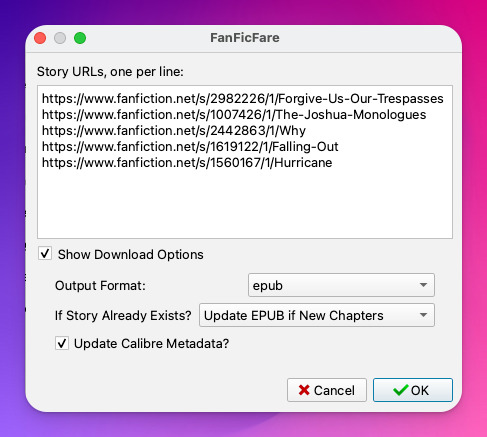
Now, in this case, I've already downloaded these (which FanFicFare detected), so I didn't update my library with the fic.
But I do have some updates to do from email, so let's try getting story URLs from email!
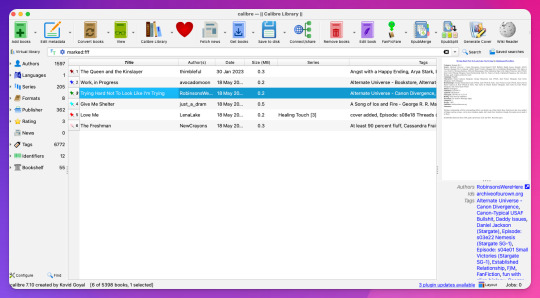
Woohoo, new fic! Calibre will detect when cover art is included in the downloaded file and use that, but at least one of these fic doesn't have cover art (which is the case for most of the fic I download). This is where Generate Cover comes in.
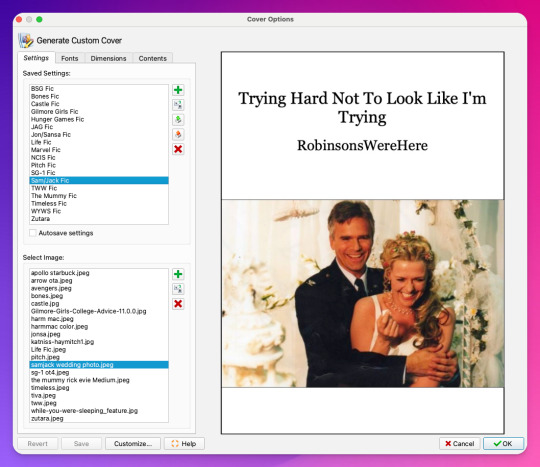
With Generate Cover, I can set the art, font, dimensions, and info content of the covers so that when I'm looking at the fic on my Kindle, I know right away what fic it is, what fandom it's from, and whether or not it's part of a series.
Okay, last thing from FanFicFare -- say I want to download all of the fic on a page, like in an author's profile on fanfic.net or all of the stories in a series. I can do that too with Get Story URLs from Web Page:
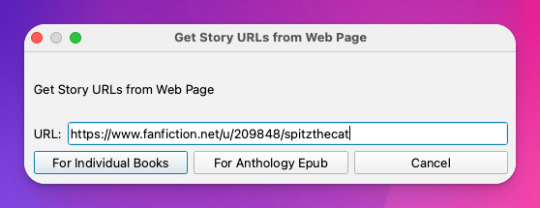
The thing I want to call out here is that I can specify whether the fic at this link are individual works or all part of an anthology, meaning if they're all works in the same series, I can download all stories as a single ebook by choosing For Anthology Epub.
Step Four: Using FireFox Reader View to Download Fic Outside of Archives
This is less common now thanks to AO3, but the elders among us may want to save fanfic that exists outside of archives on personal websites that either still exist or that exist only on the Internet Wayback Machine. FanFicFare is awesome and powerful, but it's not able to download fic from these kinds of sources, so we have to get creative.
I've done this in a couple of ways, none of which are entirely perfect, but the easiest way I've found thus far is by using Firefox's Reader View. Also, I don't think I discovered this -- I think I read about this on Tumblr, actually, although I can longer find the source (if you know it, please tell me so I can credit them!).
At any rate, open the fic in Firefox and then toggle on Reader View:
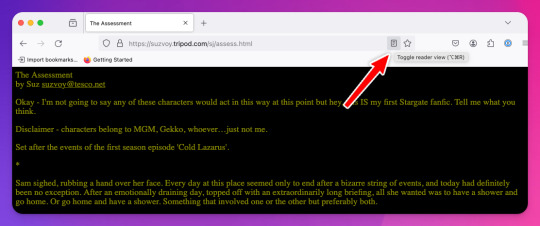
Toggling on Reader View strips all the HTML formatting from the page and presents the fic in the clean way you see in the preview below, which is more ideal for ebook formats.
To save this, go to the hamburger menu in the upper right of the browser and select Print, then switch to Print to PDF. You'll see the URL and some other stuff at the top and bottom of the pages; to remove that, scroll down until you see something like More settings... and uncheck Print headers and footers.
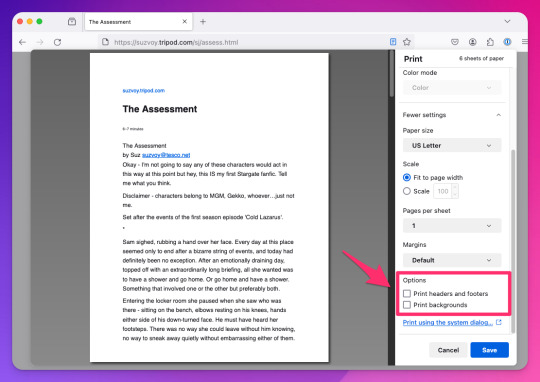
Click Save to download the resulting PDF, which you can then add to Calibre and convert to whichever format works best for your e-reader or archive method.
Step Five: Archiving (Choose Your Own Adventure)
Here's the really fun part: now that you know how to download your fave fanfics in bulk and hopefully have a nice little cache going, it's time to choose how you want to (privately) archive them!
I'm going to go through each option I've used in order of how easy it is to implement (and whether it costs additional money to use). I won't go too in depth about any of them, but I'm happy to do so in a separate post if anyone is interested.
Option 1: On Your Computer
If you're using Calibre to convert fanfic, then you're basically using your computer as your primary archive. This is a great option, because it carries no additional costs outside the original cost of acquiring your computer. It's also the simplest option, as it really doesn't require any advanced technical knowledge, just a willingness to tinker with Calibre and its plugins or to read how-to docs.
Calibre comes with a built-in e-book viewer that you can use to read the saved fic on your computer (just double-click on the fic in Calibre). You can also import it into your ebook app of choice (in most cases; this can get a little complicated just depending on how many fic you're working with and what OS you're on/app you're using).
If you choose this option, you may want to consider backing the fic up to a secondary location like an external hard drive or cloud storage. This may incur additional expense, but is likely still one of the more affordable options, since storage space is cheap and only getting cheaper, and text files tend to not be that big to begin with, even when there are a lot of them.
Option 2: On Your e-Reader
This is another great option, since this is what Calibre was built for! There are some really great, afforable e-readers out there nowadays, and Calibre supports most of them. Of course, this is a more expensive option because you have to acquire an e-reader in addition to a computer to run Calibre on, but if you already have an e-reader and haven't considered using it to read fanfic, boy are you in for a treat!
Option 3: In BookFusion
This is a really cool option that I discovered while tinkering with Calibre and used for about a year before I moved to a self-hosted option (see Option 4).
BookFusion is a web platform and an app (available on iOS and Android) that allows you to build your own ebook library and access it from anywhere, even when you're offline (it's the offline bit that really sold me). It has a Calibre plugin through which you can manage your ebook library very easily, including sorting your fanfic into easy-to-access bookshelves. You may or may not be able to share ebooks depending on your subscription, but only with family members.
Here's what the iOS app looks like:
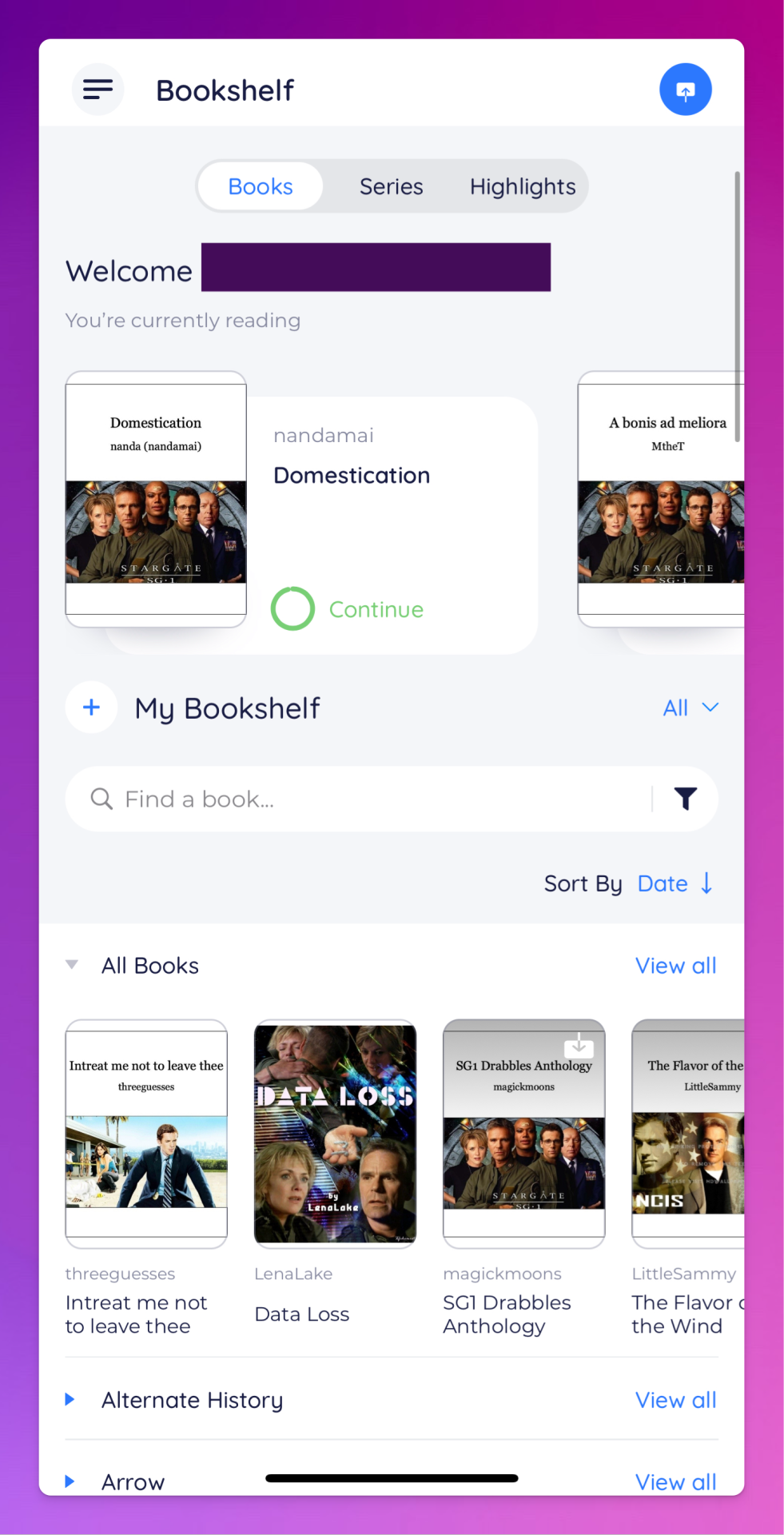
The downside to BookFusion is that you'll need a subscription if you want to upload more than 10 ebooks. It's affordable(ish), ranging from $1.99 per month for a decent 5GB storage all the way to $9.99 for 100GB for power users. Yearly subs range from $18.99 to $95.99. (They say this is temporary, early bird pricing, but subscribing now locks you into this pricing forever.)
I would recommend this option if you have some cash to spare and you're really comfortable using Calibre or you're a nerd for making apps like BookFusion work. It works really well and is incredibly convenient once you get it set up (especially when you want to read on your phone or tablet offline), but even I, someone who works in tech support for a living, had some trouble with the initial sync and ended up duplicating every ebook in my BookFusion library, making for a very tedious cleanup session.
Option 4: On a Self-Hosted Server Using Calibre-Web
Do you enjoy unending confusion and frustration? Are you okay with throwing fistfuls of money down a well? Do you like putting in an incredible amount of work for something only you and maybe a few other people will ever actually use? If so, self-hosting Calibre-Web on your own personal server might be a good fit for you!
To be fair, this is likely an experience unique to me, because I am just technical enough to be a danger to myself. I can give a brief summary of how I did this, but I don't know nearly enough to explain to you how to do it.
Calibre-Web is a web app that works on top of Calibre, offering "a clean and intuitive interface for browsing, reading, and downloading eBooks."
I have a network-attached storage (NAS) server on which I run an instance of Calibre and Calibre-Web (through the miracle that is Docker). After the initial work of downloading all the fic I wanted to save and transferring it to the server, I'm now able to download all new fic pretty much via email thanks to FanFicFare, so updating my fic archive is mostly automated at this point.
If you're curious, this is what it looks like:

Pros: The interface is clean and intuitive, the ebook reader is fantastic. The Discover feature, in which you are given random books / fic to read, has turned out to be one feature worth all the irritation of setting up Calibre-Web. I can access, read, and download ebooks on any device, and I can even convert ebooks into another format using this interface. As I mentioned above, updating it with fic (and keeping the Docker container itself up to date) is relatively automated and easy now.
Cons: The server, in whichever form you choose, costs money. It is not cheap. If you're not extremely careful (and sometimes even if you are, like me) and a hard drive goes bad, you could lose data (and then you have to spend more money to replace said hard drive and time replacing said data). It is not easy to set up. You may, at various points in this journey, wish you could launch the server into the sun, Calibre-Web into the sun, or yourself into the sun.
Step Six: Profit!
That's it! I hope this was enough to get you moving towards archiving your favorite fanfic. Again, if there's anything here you'd like me to expand on, let me know! Obviously I'm a huge nerd about this stuff, and love talking about it.
#genie's stuff#calibre#calibre-web#bookfusion#personal fanfic archive#archiving fanfic#saving fanfic
103 notes
·
View notes
Text
Weirdly Motivated to Write



Well, I did say that I have a new keyboard—to correct my posture and not look like a pretzel while I work remotely. Small victories, right?
Now, let’s talk about motivation. Because for some reason, I am absolutely buzzing with it today. Is it because of my keyboard? Most likely. Is that weird? Probably. But hey, I never claimed to be normal.
See, besides being a full-time student, I also have a job. And that job? Writing. Creating. Capturing life in words, pictures, and fleeting moments of inspiration. Filming, writing, photography—these are the things that make me absolutely happy. And honestly? Life is just too beautiful not to share.
There’s something about having the right tools that makes everything feel different. You could give me the exact same blank document yesterday, and I wouldn’t have been nearly as eager to write as I am today. But now? With my new keyboard? I feel like I could churn out a whole novel, rewrite history, or at the very least, write an unnecessarily long blog post about why I feel like writing.
Maybe it’s the clickity-clackity. (Yes, that’s a technical term.) There’s just something deeply satisfying about hearing each keystroke, like a tiny round of applause with every word I type. It’s hypnotizing. Encouraging. Addictive, even. Without it, I don’t think I’d be half as motivated to write.
And that brings me to a very important question:
Could this mean my iPad will replace my laptop?
Ha! Not a chance. Never. Not in a million years.
As much as I love this setup, there are things my iPad just cannot do. And honestly, those things make a huge difference in my daily workflow. Don’t get me wrong—iPads are fantastic. They’re lightweight, portable, and perfect for quick notes, reading, or sketching. But when it comes to serious work? My Windows laptop remains irreplaceable.



Why My Windows Laptop Wins Every Time
Multitasking Like a Pro iPads have some multitasking capabilities, but let's be real—nothing beats having multiple windows open, side by side, without limitations. On my laptop, I can have a research paper in one window, my notes in another, a video playing on the side, and Spotify running in the background. Try doing that on an iPad without constantly swiping between apps. It’s just not the same.
File Management That Actually Makes Sense The Windows file system is superior. Hands down. Drag-and-drop functionality, proper file explorer, external drive support—it’s just easier. iPads, on the other hand, have a clunky file system that often makes me want to scream into the void. Copying files? Moving them? Finding them again? It takes way longer than it should.
Software Compatibility & Heavy-Duty Programs This one’s a dealbreaker. There are so many professional-grade applications that just don’t run on iPads. Things like:
Adobe Premiere Pro for serious video editing (iPad versions are limited)
Photoshop & Illustrator (yes, they have mobile versions, but they’re nowhere near as powerful)
Microsoft Excel with Macros (because let's be honest, the iPad version is lacking)
Programming software & full IDEs (if I ever decide to code, my iPad will just sit there, useless)
Mouse & Keyboard Freedom Yes, iPads can connect to a mouse and keyboard, but do they truly function like a laptop? Nope. There are still weird limitations. Right-clicking? Custom shortcuts? The precision of a real trackpad or external mouse? Windows just does it better. Period.
Downloading Anything Without Jumping Through Hoops iPads don’t let you download everything you want, especially if it’s outside the App Store. Need a program that isn’t on Apple’s list of approved software? Too bad. Meanwhile, on Windows? I can download whatever I want, whenever I want, however I want. No restrictions.
Serious Writing & Formatting Writing on an iPad is fine for quick drafts, but when it comes to formatting long documents, citations, and exporting files in different formats? My laptop is my best friend. Whether it's proper PDF editing, running reference managers like Zotero, or managing multiple Word documents with complex layouts, iPads just don’t cut it.
Gaming & Emulation Okay, maybe not work-related, but still important! iPads have mobile games, sure. But do they run full-fledged PC games? Nope. Can I use them for game modding? Nope. Can I play older games with emulators? Again, nope. My Windows laptop, on the other hand? Unlimited possibilities.
The Verdict?
As much as I love the convenience of my iPad + keyboard combo, it will never replace my laptop. Ever. My laptop is where the real magic happens—the deep work, the serious projects, the things that actually require a proper computer.
But will I still use my iPad for writing on the go? Absolutely. Because nothing beats the clickity-clackity joy of my new keyboard. And if that keeps me weirdly motivated to write, then hey—I’ll take it.
So if you ever see me typing away somewhere, looking ridiculously focused, just know—it’s not me. It’s the keyboard.
#book#books#bookstore#new books#book review#booklr#books and reading#bookworm#book quotes#book blog#old books#bookblr#books & libraries#read#reading#reader#currently reading#long reads#library#literature#classic literature#english literature#book lover#english#classic#classics#bookshelf#bookshelves#productivity#ipad
10 notes
·
View notes